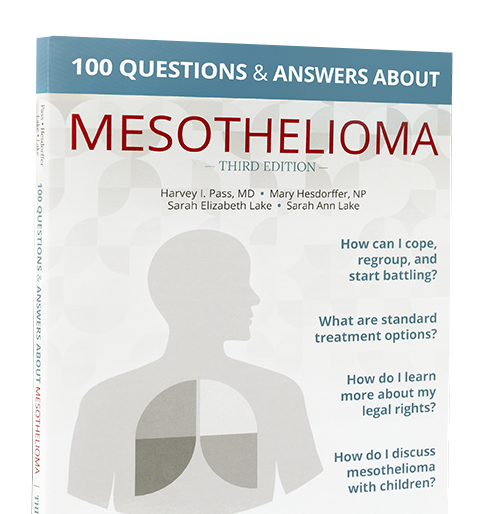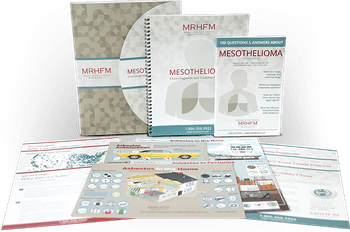Pleurodesis is a procedure used to cause the layers of the pleura, the lining of the lung, to adhere together. A chemical or medication is inserted into the space between the two layers of the pleura causing inflammation that adheres the two layers together. With malignant mesothelioma, pleurodesis may be used to prevent recurring build-up of fluid surrounding the lungs by eliminating the pleural space where fluid accumulates and presses on the lung. Pleural effusions, which is the buildup of fluid in the pleural space, are most commonly caused by cancer, heart failure, liver failure and kidney failure. Talc pleurodesis is generally used to treat pleural effusions caused by cancer in the lungs or malignant mesothelioma in the lining of a lung or lungs and not those effusions in the heart, liver or kidney.
Thoracoscopic talc pleurodesis or talc slurry pleurodesis are performed when a pleural effusion, a fluid build-up in the space between the outer lining of the lungs and internal chest wall, occurs. This buildup causes pressure on the lung, which may result in chest pain, coughing, shortness of breath and/or collapsing of the lung. Your mesothelioma doctor will determine the best approach to pleurodesis for each patient. The procedure can be done either through a chest drain under local anesthetic or by tube with a camera under general anaesthetic.
Benefits of Pleurodesis
- All fluid is removed
- Lungs are allowed to re-expand
- Breathing is improved
- Fluid is prevented from returning or reduced
- Need for regular pleural aspirates (tap) are reduced
Risks Associated with Pleurodesis
- Anesthetic complications: Reactions to anesthetic can occur as with any procedure performed with general anesthetic. These reactions are uncommon, but can be severe.
- Complications of the operation: Complications can occur with any procedure. The complications specific to surgeries involving the pleura include:
- Air leaks – There is the chance of some air leakage from the lungs in the places where the lung has been divided, stapled, sewn or cut. If the lung is slow to re-inflate and heal a portable flutter bag drain may be required
- Infection – the use of a material like talc in a surgery can increase the risk of infection. A Pleur-X catheter is sometimes used as infection can become a problem if the lung does not expand.
- Failure of the lung to re-expand – sometimes a drain may be left in place connected to a flutter valve bag to reduce small pockets of fluid remaining, allowing the lung to expand over time following the surgery. Other times, if the lung has a poor chance of expanding, a Pleur-X catheter may be used in place of the talc. This small tube goes through the skin and a nurse or other medical profession can drain any fluid buildup.
- Postoperative pain: Local anesthetic will be used to treat the pain at the thoracoscopy port sites for the first 12-24 hours. Pain medication may be provided for home use and pain should decrease within several days especially once the drains have been removed.
Types of Pleurodesis
1. Thoracoscopic (VATS) Talc Pleurodesis
General anesthetic is used to perform this type of pleurodesis. The lung is collapsed to allow the surgeon to access the pleural cavity or lining of the lung. Incisions between the ribs are made to allow video-assisted throacoscopy to be used. A camera is placed in one incision while another incision may be used for instruments.
All fluid is removed from the pleural cavity and the surgeon may take a biopsy from the lung or the lining of the lung. The surgeon may divide adhesions that are preventing the lung from re-expanding. Talc powder is then blown into the pleural cavity to coat the inside of the ribs and the lung surface. This talc causes inflammation which causes the lung to stick to the inside of the ribcage leaving no space for fluid to collect.
2. Bedside Talc Slurry Pleurodesis
When no biopsy is needed and there are no adhesions present that need to be divided, a chest drain can sometimes be used to perform the talc pleurodesis. Local anesthetia may be used over the ribs and a cut is made to insert a tube which is sutured to the skin and attached to a drainage bottle.
The drain is then clamped and a syringe containing a “slurry” made of talc and saline solution is connected to the tube. The slurry is injected and the drain is then re-clamped. In order to distribute the talc slurry over the surface of the ribs and lungs, medical staff may place you in a series of positions for around 10 minutes per position.
Approximately one hour after the slurry is injected, the clamp will be removed from your drain to allow excess saline and talc slurry to drain. This drain is generally removed following an x-ray the day after the procedure.
Precautions
The risk of bleeding may be increased if you are taking medications which may thin the blood. Alternative prescriptions up to two weeks prior to the procedure, or earlier admittance may be required. Inform your doctor if you are taking any of the following medications:
- Warfarin
- Aspirin
- Plavix (Clopidogrel)
- Drugs for treating arthritis such as :
- Voltarol (diclofenac)
- Indocid (indomethacin)
- Brufen (ibuprofen)
- Ketoralac
- Mobic (meloxicam)
- Celebrex (celecoxib)
- Vioxx (rofecoxib)
- Advil
- Neurofen
- Feldene
If you have any questions, do not hesitate to give us a call at 800.259.9249 or contact us online.





